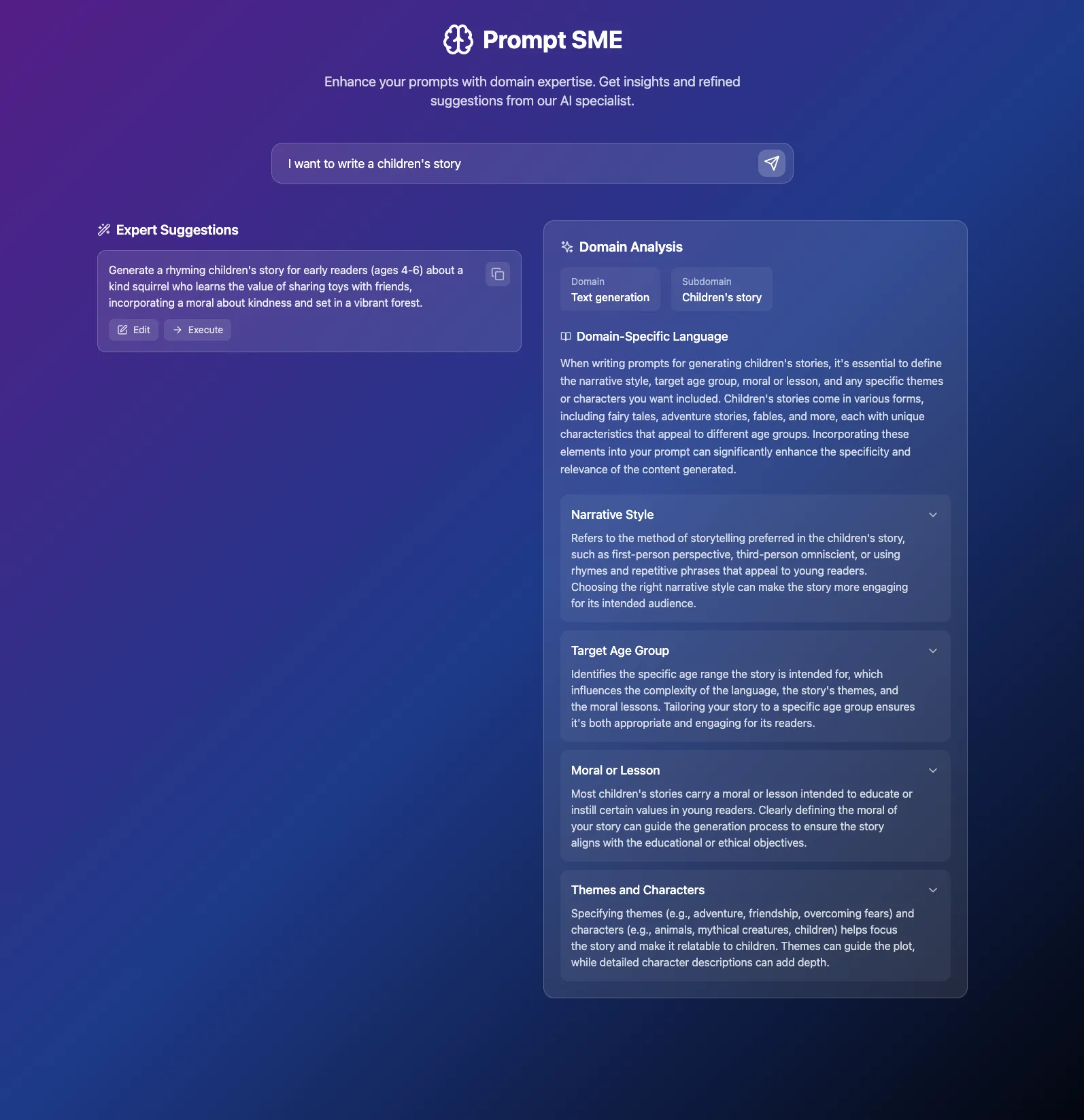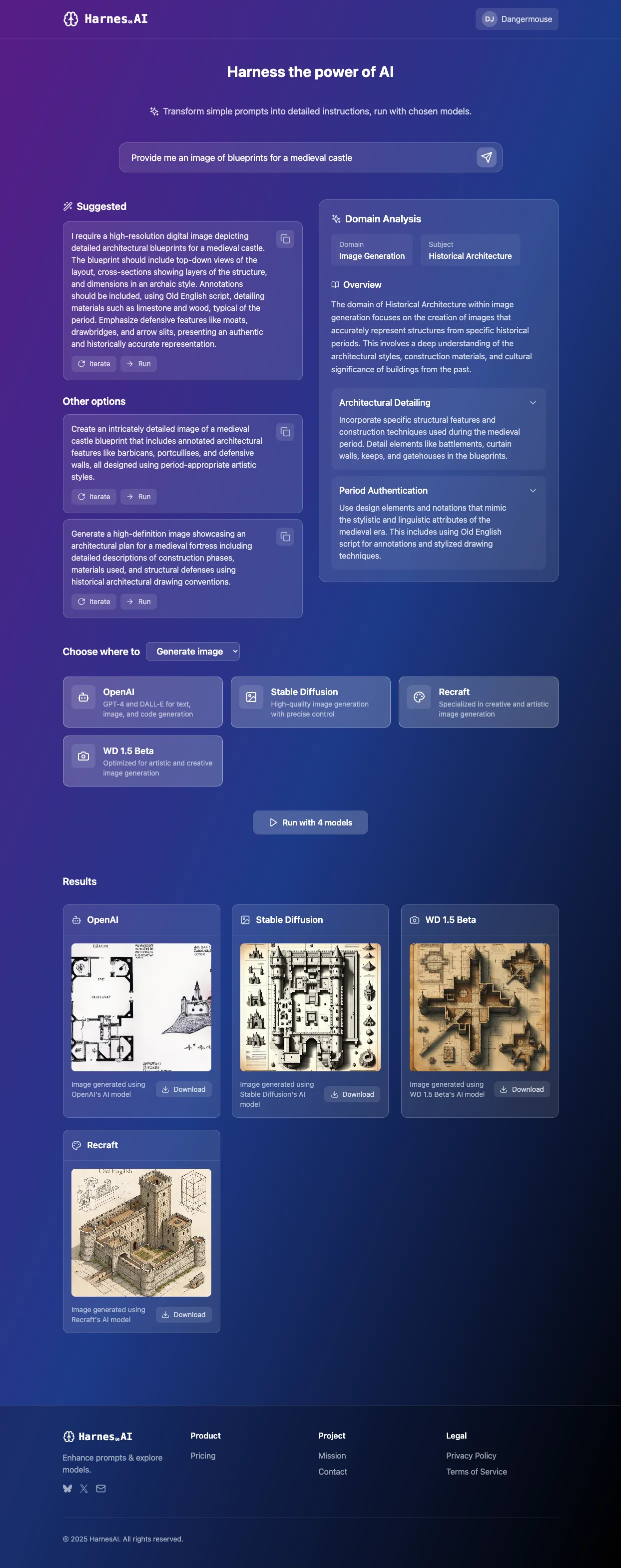Is it possible to create a software business without coding? In my case: yes, sort of. This article explores the creation of
A small idea had popped up. Wishing to generate an image I recalled popular prompt examples using Midjourney—one of the first image generation models, circa 2022. The best results were achieved by expert photographers that provided richly detailed image descriptions, including lens types, lighting conditions, and other domain specific terminology. I don’t have that kind of expertise, but I still want the same kinds of results!
Would it be possible to use AI to enhance simple prompts into highly specific ones, with AI educating or reminding users of relevant domain-specific concepts and terminology? Could this be generally useful—both a tool and a learning experience for improved prompting?
With this idea in mind, I began experimenting with
I started with a simple prompt instructing Bolt to build a “subject matter expert helper” that greeted the user with a single text input field. Upon submission, the tool should display prompt suggestions (placeholders initially). Finally, it should feature a modern interface with gradients similar to Bolt itself. I pressed the return key.

The initial result was truly impressive, but what happened over the next hours as I played with it further totally blew my mind. I had worked with AI, but not like this. Building software with AI to date involved asking AI to generate, or interpret individual files of code to make modifications. Bolt not only worked seamlessly across files, it understood prompt intent extremely well, making perfectly appropriate updates and tweaks. Of course, reviewing the code was a matter of professional curiosity, not necessity: a working application preview was updated after every prompt.
I continued adding features and iterating, including integrating OpenAI for real responses. This was handled seamlessly. So well, that the project’s scope expanded. Inspired by “indie hackers” (independent software developers who launch small scale businesses), I decided to create a Minimum Viable Product (MVP) – you know, something I could actually launch, accept payments, the whole shebang. A mini-business.
Bolt integrated the required services effortlessly… mostly. The first hurdle was testing the signup workflow. This was difficult within Bolt’s preview area due to Google’s authentication mechanism. So, I transitioned to a local setup which slowed down iteration. For the first time, I slid into leveraging my programming experience, as it was faster to copy-paste code changes. While perhaps not strictly necessary, it was more efficient.
As the codebase grew, Bolt started to struggle. It reported the prompt history had become excessively large and began forgetting earlier context. At the database level, some functionalities started to malfunction, and this forcibly pushed me down the coding rabbit hole.
One of the biggest challenges, was keeping up with the code Bolt had written. It was generating code in areas I wasn’t particularly well-versed in! To debug, I had to learn about the code it was writing. Ironically, in attempting to avoid coding altogether, I ended up neck-deep in it.
I was so close to having this amazing proof of concept for a code-free online software business, yet clear gaps required manual intervention. In the end, it took me a few ordinary, slow coding days (even with AI assistance) to finish the project.

Bolt is truly remarkable, and is hands-down the most profound experience I’ve had working with AI. Its ability to interpret prompt intent and make appropriate changes is just… wow. Nonetheless, the 80/20 rule applied: Bolt generated 80% of what was required in a day, including requiring me signing up to necessary services. Then I spent four days finishing the remaining 20% by hand 🤦. This experience aligns with the observations in this article entitled “The 70% problem: Hard truths about AI-assisted coding” which excellently explains the phenomenon of working with AI as I had experienced it. I recommend the read.
Despite its limitations, Bolt’s power is undeniable. Most importantly, it marks only the very beginning of coding-free software development. We are so early in the AI revolution, with so many significant oppurtunities to improve the AI end-user experience. With trillions of dollars being poured into this field, unless it breaks the laws of physics, these tools will improve dramatically, and quickly. This experience was a complete validation of the impact of AI and the need to embrace it.
Try out
